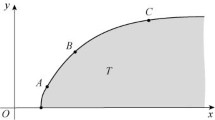Abstract
Data envelopment analysis (DEA) is commonly used to measure the relative efficiency of decision-making units. Often, in a second stage, a regression model is estimated to relate DEA efficiency scores to exogenous factors. In this paper, we argue that the traditional linear or tobit approaches to second-stage DEA analysis do not constitute a reasonable data-generating process for DEA scores. Under the assumption that DEA scores can be treated as descriptive measures of the relative performance of units in the sample, we show that using fractional regression models is the most natural way of modeling bounded, proportional response variables such as DEA scores. We also propose generalizations of these models and, given that DEA scores take frequently the value of unity, examine the use of two-part models in this framework. Several tests suitable for assessing the specification of each alternative model are also discussed.




Similar content being viewed by others
Notes
See Duan (1983) for a seminal paper on the consequences for prediction of using logged dependent variables.
Note that, under the assumption that S(·) is an invertible function, we may write \(L\left( x\theta \right) =S\left\{ S^{-1}\left[ L\left( x\theta \right) \right] \right\} \), where \( S^{-1}\left[ L\left( x\theta \right) \right] \) is a nonlinear function of xθ that can be approximated by a polynomial.
Full results are available from the authors on request.
References
Aranda-Ordaz FJ (1981) On two families of transformations to additivity for binary response data. Biometrika 68(2):357-363
Banker RD, Natarajan R (2008) Evaluating contextual variables affecting productivity using data envelopment analysis. Oper Res 56(1):48–58
Chilingerian JA (1995) Evaluating physician efficiency in hospitals: a multivariate analysis of best practices. Eur J Oper Res 80:548–574
Coelli TJ, Rao DS, O’Donnell CJ, Battese GE (2005) An introduction to efficiency and productivity analysis, 2nd edn. Springer, New York
Czado C (1994) Parametric link modification of both tails in binary regression. Stat Papers 35:189-201
Daraio C, Simar L (2005) Introducing environmental variables in nonparametric frontier models: a probabilistic approach. J Prod Anal 24:93–121
Davidson R, MacKinnon JG (1981) Several tests for model specification in the presence of alternative hypotheses. Econometrica 49(3):781–793
Duan N (1983) Smearing estimate: a nonparametric retransformation method. J Am Stat Assoc 78:605–610
Gillespie J, Schupp A, Taylor G (1997) New alternative enterprise: the case of ratite industry. J Agric Appl Econ 29(2):409–418
Gouriéroux C, Monfort A (1994) Testing non-nested hypotheses. In: Engle RF, McFadden DL (eds) Handbook of econometrics, volume IV. Elsevier Science, Amsterdam, pp 2585–2637
Gouriéroux C, Monfort A, Trognon A (1984) Pseudo maximum likelihood methods: applications to Poisson models. Econometrica 52(3):701–720
Grosskopf S (1996) Statistical inference and nonparametric efficiency: a selective survey. J Prod Anal 7:161–176
Hoff A (2007) Second stage DEA: comparison of approaches for modelling the DEA score. Eur J Oper Res 181:425–435
Kneip A, Park BU, Simar L (1998) A note on the convergence of nonparametric DEA estimators for production efficiency scores. Econ Theory 14:783–793
Kravtsova V (2008) Foreign presence and efficiency in transition economies. J Prod Anal 29:91–102
Latruffe L, Davidova S, Balcombe K (2008) Application of a double bootstrap to investigation of determinants of technical efficiency of farms in Central Europe. J Prod Anal 29:183–191
McDonald J (2009) Using least squares and tobit in second stage DEA efficiency analyses. Eur J Oper Res 197(2):792–798
McDonald JF, Moffitt RA (1980) The uses of tobit analysis. Rev Econ Stat 62(2):318–321
Nagler J (1994) Scobit: an alternative estimator to logit and probit. Am J Polit Sci 38(1):230–255
Pagan A, Vella F (1989) Diagnostic tests for models based on individual data: a survey. J Appl Econ 4:S29–S59
Papke LE, Wooldridge JM (1996) Econometric methods for fractional response variables with an application to 401(k) plan participation rates. J Appl Econ 11(6):619-632
Poirier DJ (1980) A Lagrange multiplier test for skewness in binary models. Econ Lett 5:141–143
Pregibon D (1980) Goodness of link tests for generalized linear models. Appl Stat 29(1):15–24
Prentice RL (1976) A generalization of the probit and logit methods for dose response curves. Biometrics 32:761–768
Ray SC (1991) Resource-use efficiency in public schools: a study of Connecticut data. Manag Sci 37(12):1620–1628
Ramalho EA, Ramalho JJS, Murteira J (2010) Alternative estimating and testing empirical strategies for fractional regression models. J Econ Surv. doi:10.1111/j.1467-6419.2009.00602.x
Ruggiero J (1998) Non-discretionary inputs in data envelopment analysis. Eur J Oper Res 111:461–469
Simar L, Wilson P (2007) Estimation and inference in two-stage, semi-parametric models of production processes. J Econ 136:31–64
Smith RJ (1989) On the use of distributional misspecification checks in limited dependents variable models. Econ J 99:178–192
Stukel TA (1988) Generalized logistic models. J Am Stat Assoc 83(402):426–431
Taylor JMG (1988) The cost of generalizing logistic regression. J Am Stat Assoc 83(404):1078–1083
Wang H, Schmidt P (2002) One-step and two-step estimation of the effects of exogenous variables on technical efficiency levels. J Prod Anal 18:129–144
Whitemore AS (1983) Transformations to linearity in binary regression. SIAM J Appl Math 43(4):703–710
Wooldridge JM (2002) Econometric analysis of cross section and panel data. The MIT Press, Cambridge
Zelenyuk V, Zheka V (2006) Corporate governance and firm’s efficiency: the case of a transitional country, Ukraine. J Prod Anal 25:143–157
Acknowledgments
The authors thank the editor, an associate editor and the referees for valuable comments that helped to substantially improve the paper. Financial support from Fundação para a Ciência e a Tecnologia is also gratefully acknowledged (grant PTDC/ECO/64693/2006).
Author information
Authors and Affiliations
Corresponding author
Rights and permissions
About this article
Cite this article
Ramalho, E.A., Ramalho, J.J.S. & Henriques, P.D. Fractional regression models for second stage DEA efficiency analyses. J Prod Anal 34, 239–255 (2010). https://doi.org/10.1007/s11123-010-0184-0
Published:
Issue Date:
DOI: https://doi.org/10.1007/s11123-010-0184-0




